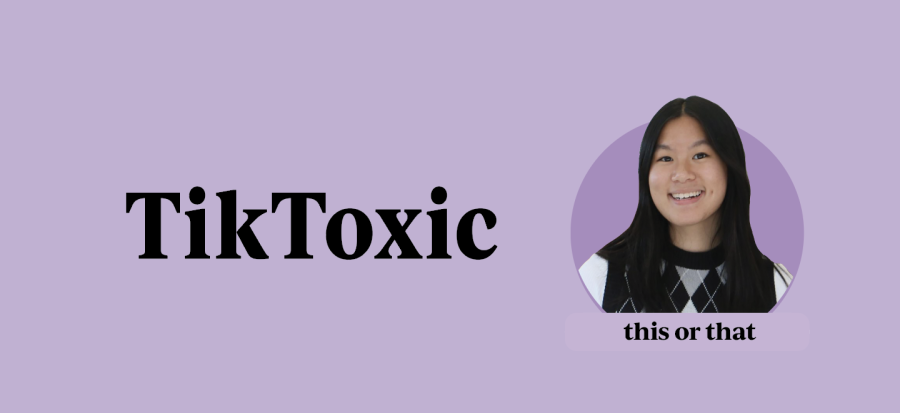She starts her morning at 5 a.m. to the sounds of birds chirping. She immediately heads to the gym in her monochrome outfit. She’s back by 7 a.m. where she makes a green smoothie. She slowly sips on it as she writes daily affirmations in her journal. By the time she’s done, it’s only 8 a.m.—she has an entire day in front of her. This is the routine of a “That girl,” the ideal self as popularized by TikTok.
This ideal stereotype came about sometime in April 2021, in which people sought out to better themselves by focusing on their wellness and achieving their lifelong goals. In doing so, they produced TikToks to provide tips to others on how to achieve a lifestyle like theirs. Seems harmless, right? It was, until the trend started focusing on the wrong things. No longer was it focused on providing tips to other people seeking to build healthy habits; instead the trend focused on how to best present their life in the most visually appealing way. As a result, “That girl” videos became extremely homogeneous; rich, skinny, predominantly-white women seemed to be the only girls who could achieve such a lifestyle, in turn putting down others who didn’t fit the archetype.
In an article published by CBC News, Jennifer Mills, a registered clinical psychologist and an associate professor of psychology at York University in Toronto, found in her study that such content triggers feelings of inadequacy rather than motivation. When one consistently sees the same image, it conveys the message that there’s only one way to be productive. This can pose an extreme burden, especially financially. In many of the “That girl” videos, girls indulge in 10-step skincare routines and expensive brands. This does two things: it excludes those who are financially unable to buy such items and it promotes the toxic mentality that consumerism is a necessary factor for productivity and success. No one needs the newest iPad to be successful, yet the messaging within “That girl” videos seems to convey just that.
Moreover, “That girl” videos tend to promote unhealthy habits, such as under-eating and lack of sleep. With such girls only eating a smoothie for breakfast, it presents extremely low-calorie, carb-lacking meals as aesthetically beautiful, ignoring its impacts on health. Furthermore, by promoting the idea that one must wake up at 5 a.m. to be productive, it only further contributes to the existing sleep epidemic that exists. The trend is counterproductive—something meant to promote wellness is only promoting unhealthy habits that are essential to one’s well being.
At the end of the day, there’s nothing wrong with trying to better yourself, but stop trying to be “THAT girl,” and prioritize being “YOUR self.”
Click here to see more of Leah Tan’s work.

































![AI in films like "The Brutalist" is convenient, but shouldn’t take priority [opinion]](https://hilite.org/wp-content/uploads/2025/02/catherine-cover-1200x471.jpg)









































![Review: “The Immortal Soul Salvage Yard:” A criminally underrated poetry collection [MUSE]](https://hilite.org/wp-content/uploads/2025/03/71cju6TvqmL._AC_UF10001000_QL80_.jpg)
![Review: "Dog Man" is Unapologetically Chaotic [MUSE]](https://hilite.org/wp-content/uploads/2025/03/dogman-1200x700.jpg)
![Review: "Ne Zha 2": The WeChat family reunion I didn’t know I needed [MUSE]](https://hilite.org/wp-content/uploads/2025/03/unnamed-4.png)
![Review in Print: Maripaz Villar brings a delightfully unique style to the world of WEBTOON [MUSE]](https://hilite.org/wp-content/uploads/2023/12/maripazcover-1200x960.jpg)
![Review: “The Sword of Kaigen” is a masterpiece [MUSE]](https://hilite.org/wp-content/uploads/2023/11/Screenshot-2023-11-26-201051.png)
![Review: Gateron Oil Kings, great linear switches, okay price [MUSE]](https://hilite.org/wp-content/uploads/2023/11/Screenshot-2023-11-26-200553.png)
![Review: “A Haunting in Venice” is a significant improvement from other Agatha Christie adaptations [MUSE]](https://hilite.org/wp-content/uploads/2023/11/e7ee2938a6d422669771bce6d8088521.jpg)
![Review: A Thanksgiving story from elementary school, still just as interesting [MUSE]](https://hilite.org/wp-content/uploads/2023/11/Screenshot-2023-11-26-195514-987x1200.png)
![Review: "When I Fly Towards You", cute, uplifting youth drama [MUSE]](https://hilite.org/wp-content/uploads/2023/09/When-I-Fly-Towards-You-Chinese-drama.png)
![Postcards from Muse: Hawaii Travel Diary [MUSE]](https://hilite.org/wp-content/uploads/2023/09/My-project-1-1200x1200.jpg)
![Review: "Ladybug & Cat Noir: The Movie," departure from original show [MUSE]](https://hilite.org/wp-content/uploads/2023/09/Ladybug__Cat_Noir_-_The_Movie_poster.jpg)
![Review in Print: "Hidden Love" is the cute, uplifting drama everyone needs [MUSE]](https://hilite.org/wp-content/uploads/2023/09/hiddenlovecover-e1693597208225-1030x1200.png)
![Review in Print: "Heartstopper" is the heartwarming queer romance we all need [MUSE]](https://hilite.org/wp-content/uploads/2023/08/museheartstoppercover-1200x654.png)




